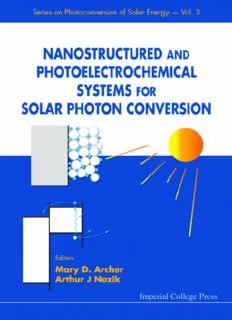
Photochemical Photoelectrochemical Approaches to Solar Energy Conversion PDF
Preview Photochemical Photoelectrochemical Approaches to Solar Energy Conversion
NANOSTRUCTURED AND PHOTOELECTROCHEMICAL SYSTEMS FOR SOLAR PHOTON CONVERSION A-PDF Merger DEMO : Purchase from www.A-PDF.com to remove the watermark SERIES ON PHOTOCONVERSION OF SOLAR ENERGY Series Editor: Mary D. Archer (Cambridge, UK) Vol. 1: Clean Electricity from Photovoltaics eds. Mary D. Archer & Robert Hill Vol. 2: Molecular to Global Photosynthesis eds. Mary D. Archer & Jim Barber Vol. 3: Nanostructured and Photoelectrochemical Systems for Solar Photon Conversion eds. Mary D. Archer & Arthur J. Nozik Forthcoming From Solar Photons to Electrons and Molecules by Mary D. Archer Wanda - Nonostructured & Photoelectrochemica2l.pmd 6/13/2008, 2:01 PM Series on Photoconversion of Solar Energy — Vol. 3 NANOSTRUCTURED AND PHOTOELECTROCHEMICAL SYSTEMS FOR SOLAR PHOTON CONVERSION Editors Mary D. Archer Imperial College, UK Arthur J Nozik National Renewable Energy Laboratory, USA Imperial College Press ICP Published by Imperial College Press 57 Shelton Street Covent Garden London WC2H 9HE Distributed by World Scientific Publishing Co. Pte. Ltd. 5 Toh Tuck Link, Singapore 596224 USA office: 27 Warren Street, Suite 401-402, Hackensack, NJ 07601 UK office: 57 Shelton Street, Covent Garden, London WC2H 9HE British Library Cataloguing-in-Publication Data A catalogue record for this book is available from the British Library. Series on Photoconversion of Solar Energy — Vol. 3 NANOSTRUCTURED AND PHOTOELECTROCHEMICAL SYSTEMS FOR SOLAR PHOTON CONVERSION Copyright © 2008 by Imperial College Press All rights reserved. This book, or parts thereof, may not be reproduced in any form or by any means, electronic or mechanical, including photocopying, recording or any information storage and retrieval system now known or to be invented, without written permission from the Publisher. For photocopying of material in this volume, please pay a copying fee through the Copyright Clearance Center, Inc., 222 Rosewood Drive, Danvers, MA 01923, USA. In this case permission to photocopy is not required from the publisher. ISBN-13978-1-86094-255-6 ISBN-101-86094-255-5 Printed in Singapore. Wanda - Nonostructured & Photoelectrochemica1l.pmd 6/13/2008, 2:01 PM This volume is dedicated to ć ć Olga I. Mi i 21 December 21 1934 – 24 May 2006 a fine scientist and pioneer in the field of quantum dots TThhiiss ppaaggee iinntteennttiioonnaallllyy lleefftt bbllaannkk CONTENTS About the authors xi Preface xix 1 Overview M. D. Archer 1.1 Themes 1 1.2 Historical perspective 6 1.3 Extremely thin absorber (ETA) cells 10 1.4 Organic solar cells 12 1.5 Dye-sensitised solar cells (Grätzel cells) 16 1.6 Regenerative solar cells 18 1.7 Future prospects 23 App. The vacuum scale of electrode potential and the concept of the 24 1A solution Fermi level 1A.1 SHE and SCE scales of electrode potential 25 1A.2 Absolute electrode potentials 25 1A.3 Absolute electrode potential of the SHE 27 1A.4 The solution Fermi level 28 1A.5 Vacuum scale of electrode potential 29 2 Fundamentals in photoelectrochemistry R. J. D. Miller and R. Memming 2.1 Introduction 39 2.2 Photophysics of semiconductors and semiconductor particles 41 2.3 Carrier relaxation 55 2.4 Charge transfer at the semiconductor–electrolyte interface 84 2.5 Conversion of solar energy 120 2.6 Photocatalysis 130 2.7 Summary 132 3 Fundamentals and applications of quantum-confined structures A. J. Nozik 3.1 Introduction 147 3.2 Quantisation effects in semiconductor nanostructures 151 vii viii Contents 3.3 Optical spectroscopy of quantum wells, superlattices and quantum dots 163 3.4 Hot electron and hole cooling dynamics in quantum-confined 167 semiconductors 3.5 High conversion efficiency via multiple exciton generation in quantum 176 dots 3.6 Quantum dot solar cell configurations 190 3.7 Summary and conclusions 194 4 Fundamentals and applications in electron-transfer reactions M. D. Archer 4.1 Introduction 209 4.2 Historical perspective 213 4.3 Thermodynamics of ET and PET reactions 218 4.4 Classical Marcus theory 223 4.5 Semiclassical theories of nonadiabatic electron transfer 232 4.6 Electron transfer in donor–bridge–acceptor supermolecules 238 4.7 Electrochemical electron transfer 247 4.8 Rate control by reorganisation dynamics 261 4.9 Optimisation of photoinduced electron transfer in photoconversion 263 App. Solution density-of-states functions 265 4A App. Derivation of high-temperature limit Marcus rate equation for 266 4B homogeneous electron transfer using density-of-states approach 5 Fundamentals in metal-oxide heterogeneous photocatalysis N. Serpone and A. V. Emeline 5.1 Introduction 275 5.2 The complex science underlying metal-oxide photocatalysis 277 5.3 Metal-oxide photochemistry, photophysics and modelling 310 5.4 Challenges in heterogeneous photocatalysis 329 5.5 Theoretical description of quantum yields 345 5.6 Evidence for a gas/solid surface reaction being photocatalytic 374 5.7 Concluding remarks 381 6 Inorganic extended-junction devices R. Könenkamp 6.1 Introduction 393 6.2 Concepts for extremely thin absorber cells 398 Contents ix 6.3 Preparation of substrates, absorber and transporting layers 403 6.4 Electronic and optical aspects 419 6.5 Devices 434 6.6 Advanced photovoltaic concepts and new routes to other electronic 441 devices 6.7 Summary 443 7 Organic donor–acceptor heterojunction solar cells J. J. Benson-Smith and J. Nelson 7.1 Introduction 453 7.2 Basic principles of photovoltaic conversion in organic materials 457 7.3 Donor–acceptor bilayer devices 461 7.4 Donor–acceptor bulk heterojunction devices 465 7.5 Relationship between material and device parameters and photovoltaic 473 performance 7.6 Challenges 478 7.7 Summary 489 8 Dye-sensitised mesoscopic solar cells M. Grätzel and J. R. Durrant 8.1 Introduction 503 8.2 Historical background 504 8.3 Mode of function of dye-sensitised solar cells 505 8.4 DSSC research and development 515 8.5 Solid-state dye-sensitised cells 526 8.6 Pilot production of modules, outdoor field tests and commercial DSSC 527 development 8.7 Outlook 530 9 Semiconductor/liquid junction photoelectrochemical solar cells S. Maldonado, A. G. Fitch and N. S. Lewis 9.1 Introduction 537 9.2 Variation of the solution redox couple 539 9.3 Non-aqueous solvents 548 9.4 Chemical modification of semiconductor surfaces 551 9.5 Future directions 569
Description: